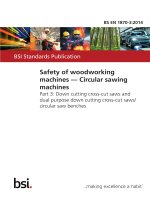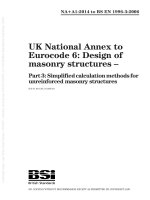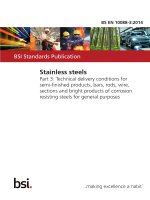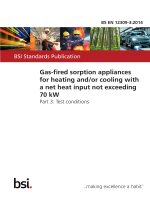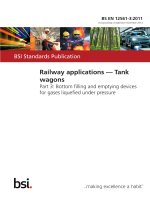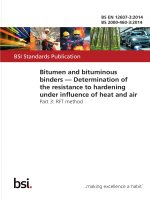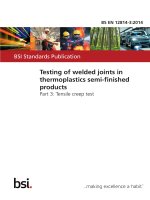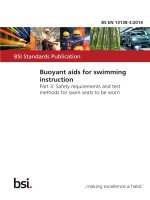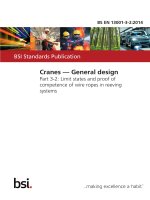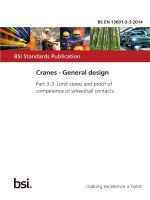Bsi bs en 62149 3 2014
Bạn đang xem bản rút gọn của tài liệu. Xem và tải ngay bản đầy đủ của tài liệu tại đây (1.19 MB, 18 trang )
BS EN 62149-3:2014
BSI Standards Publication
Fibre optic active components
and devices - Performance
standards
Part 3: Modulator-integrated laser diode
transmitters for 2,5-Gbit/s to 40-Gbit/s
fibre optic transmission systems
BRITISH STANDARD
BS EN 62149-3:2014
National foreword
This British Standard is the UK implementation of EN 62149-3:2014. It
is identical to IEC 62149-3:2014. It supersedes BS EN 62149-3:2004
which is withdrawn.
The UK participation in its preparation was entrusted by Technical
Committee GEL/86, Fibre optics, to Subcommittee GEL/86/3, Fibre optic
systems and active devices.
A list of organizations represented on this committee can be obtained on
request to its secretary.
This publication does not purport to include all the necessary provisions of
a contract. Users are responsible for its correct application.
© The British Standards Institution 2014.
Published by BSI Standards Limited 2014
ISBN 978 0 580 82163 9
ICS 33.180.20
Compliance with a British Standard cannot confer immunity from
legal obligations.
This British Standard was published under the authority of the
Standards Policy and Strategy Committee on 31 August 2014.
Amendments/corrigenda issued since publication
Date
Text affected
BS EN 62149-3:2014
EUROPEAN STANDARD
EN 62149-3
NORME EUROPÉENNE
EUROPÄISCHE NORM
July 2014
ICS 33.180.20
Supersedes EN 62149-3:2004
English Version
Fibre optic active components and devices - Performance
standards - Part 3: Modulator-integrated laser diode transmitters
for 2,5-Gbit/s to 40-Gbit/s fibre optic transmission systems
(IEC 62149-3:2014)
Composants et dispositifs actifs à fibres optiques - Normes
de performances - Partie 3: Emetteurs à diodes laser à
modulateur intégré pour des systèmes de transmission à
fibres optiques de 2,5 Gbit/s à 40 Gbit/s
(CEI 62149-3:2014)
Aktive Lichtwellenleiterbauelemente und -geräte Betriebsverhalten - Teil 3: Laserdiodensender mit
integriertem Modulator für 2,5-Gbit/s- bis 40-Gbit/sLichtwellenleiter-Übertragungssysteme
(IEC 62149-3:2014)
This European Standard was approved by CENELEC on 2014-06-30. CENELEC members are bound to comply with the CEN/CENELEC
Internal Regulations which stipulate the conditions for giving this European Standard the status of a national standard without any alteration.
Up-to-date lists and bibliographical references concerning such national standards may be obtained on application to the CEN-CENELEC
Management Centre or to any CENELEC member.
This European Standard exists in three official versions (English, French, German). A version in any other language made by translation
under the responsibility of a CENELEC member into its own language and notified to the CEN-CENELEC Management Centre has the
same status as the official versions.
CENELEC members are the national electrotechnical committees of Austria, Belgium, Bulgaria, Croatia, Cyprus, the Czech Republic,
Denmark, Estonia, Finland, Former Yugoslav Republic of Macedonia, France, Germany, Greece, Hungary, Iceland, Ireland, Italy, Latvia,
Lithuania, Luxembourg, Malta, the Netherlands, Norway, Poland, Portugal, Romania, Slovakia, Slovenia, Spain, Sweden, Switzerland,
Turkey and the United Kingdom.
European Committee for Electrotechnical Standardization
Comité Européen de Normalisation Electrotechnique
Europäisches Komitee für Elektrotechnische Normung
CEN-CENELEC Management Centre: Avenue Marnix 17, B-1000 Brussels
© 2014 CENELEC All rights of exploitation in any form and by any means reserved worldwide for CENELEC Members.
Ref. No. EN 62149-3:2014 E
BS EN 62149-3:2014
EN 62149-3:2014
-2-
Foreword
The text of document 86C/1157/CDV, future edition 2 of IEC 62149-3, prepared by SC 86C "Fibre
optic systems and active devices” of IEC/TC 86 “Fibre optics" was submitted to the IEC-CENELEC
parallel vote and approved by CENELEC as EN 62149-3:2014.
The following dates are fixed:
•
latest date by which the document has to be
implemented at national level by
publication of an identical national
standard or by endorsement
(dop)
2015-03-30
•
latest date by which the national
standards conflicting with the
document have to be withdrawn
(dow)
2017-06-30
This document supersedes EN 62149-3:2004.
Attention is drawn to the possibility that some of the elements of this document may be the subject of
patent rights. CENELEC [and/or CEN] shall not be held responsible for identifying any or all such
patent rights.
Endorsement notice
The text of the International Standard IEC 62149-3:2014 was approved by CENELEC as a European
Standard without any modification.
In the official version, for Bibliography, the following notes have to be added for the standards indicated:
IEC 60068 Series
NOTE
Harmonized as EN 60068 Series.
IEC 60793 Series
NOTE
Harmonized as EN 60793 Series.
IEC 60825 Series
NOTE
Harmonized as EN 60825 Series.
IEC 60874 Series
NOTE
Harmonized as EN 60874 Series.
IEC 62572-2
NOTE
Harmonized as EN 62572-2.
IEC 62572-3
NOTE
Harmonized as EN 62572-3.
IEC 61280 Series
NOTE
Harmonized as EN 61280 Series.
IEC 62007-2
NOTE
Harmonized as EN 62007-2.
BS EN 62149-3:2014
EN 62149-3:2014
-3-
Annex ZA
(normative)
Normative references to international publications
with their corresponding European publications
The following documents, in whole or in part, are normatively referenced in this document and are
indispensable for its application. For dated references, only the edition cited applies. For undated
references, the latest edition of the referenced document (including any amendments) applies.
NOTE 1 When an International Publication has been modified by common modifications, indicated by (mod), the relevant
EN/HD applies.
NOTE 2 Up-to-date information on the latest versions of the European Standards listed in this annex is available here:
www.cenelec.eu
Publication
Year
Title
EN/HD
Year
IEC 60068-2-1
-
EN 60068-2-1
-
IEC 60068-2-2
-
EN 60068-2-2
-
IEC 60068-2-6
-
EN 60068-2-6
-
IEC 60068-2-14
-
EN 60068-2-14
-
IEC 60068-2-27
-
EN 60068-2-27
-
IEC 60068-2-78
-
EN 60068-2-78
-
IEC 60749-7
-
EN 60749-7
-
IEC 60749-26
-
EN 60749-26
-
IEC 60825-1
-
EN 60825-1
-
IEC 60950-1
-
EN 60950-1
-
IEC 62007-1
-
EN 62007-1
-
ITU-T G.694-1
-
-
-
MIL-STD-883
-
Environmental testing -- Part 2-1: Tests Test A: Cold
Environmental testing -- Part 2-2: Tests Test B: Dry heat
Environmental testing -- Part 2-6: Tests Test Fc: Vibration (sinusoidal)
Environmental testing -- Part 2-14: Tests Test N: Change of temperature
Environmental testing -- Part 2-27: Tests Test Ea and guidance: Shock
Environmental testing -- Part 2-78: Tests Test Cab: Damp heat, steady state
Semiconductor devices - Mechanical and
climatic test methods -- Part 7: Internal
moisture content measurement and the
analysis of other residual gases
Semiconductor devices - Mechanical and
climatic test methods -- Part 26:
Electrostatic discharge (ESD) sensitivity
testing - Human body model (HBM)
Safety of laser products -- Part 1:
Equipment classification and requirements
Information technology equipment - Safety
-- Part 1: General requirements
Semiconductor optoelectronic devices for
fibre optic system applications - Part 1:
Specification template for essential ratings
and characteristics
Spectral grids for WDM applications:
DWDM frequency grid
Test methods and procedures for
microelectronics
-
-
–2–
BS EN 62149-3:2014
IEC 62149-3:2014 © IEC 2014
CONTENTS
INTRODUCTION ..................................................................................................................... 5
1
Scope .............................................................................................................................. 6
2
Normative references ...................................................................................................... 6
3
Terms, definitions and symbols ....................................................................................... 7
3.1
Terms and definitions.............................................................................................. 7
3.2
Symbols .................................................................................................................. 7
4
Product parameters ......................................................................................................... 7
4.1
Absolute limiting ratings .......................................................................................... 7
4.2
Operating environment ............................................................................................ 8
4.3
Functional specification .......................................................................................... 8
4.4
Diagrams .............................................................................................................. 10
5
Testing .......................................................................................................................... 10
5.1
General ................................................................................................................. 10
5.2
Characterization testing ........................................................................................ 10
5.3
Performance testing .............................................................................................. 11
6
Environmental specifications ......................................................................................... 13
6.1
General safety ...................................................................................................... 13
6.2
Laser safety .......................................................................................................... 13
Bibliography .......................................................................................................................... 14
Figure 1 – Schematic diagram .............................................................................................. 10
Table 1 – Absolute limiting ratings .......................................................................................... 8
Table 2 – Operating environment ............................................................................................ 8
Table 3 – Operating conditions for functional specification ...................................................... 8
Table 4 – Functional specification ........................................................................................... 9
Table 5 – Characterization tests ........................................................................................... 11
Table 6 – Performance test plan ........................................................................................... 12
Table 7 – Recommended performance test failure criteria ..................................................... 13
BS EN 62149-3:2014
IEC 62149-3:2014 © IEC 2014
–5–
INTRODUCTION
Fibre optic transmitters are used to convert electrical signals into optical signals. This part of
IEC 62149 covers the performance standard for optical modulators monolithically integrated
with laser diodes for 2,5 Gbit/s to 40 Gbit/s multi-channel optical telecommunication systems.
–6–
BS EN 62149-3:2014
IEC 62149-3:2014 © IEC 2014
FIBRE OPTIC ACTIVE COMPONENTS AND DEVICES –
PERFORMANCE STANDARDS –
Part 3: Modulator-integrated laser diode transmitters
for 2,5-Gbit/s to 40-Gbit/s fibre optic transmission systems
1
Scope
This part of IEC 62149 covers the performance specification for optical modulators
monolithically integrated with laser diodes for 2,5 Gbit/s to 40 Gbit/s multi-channel fibre optic
transmission systems. This performance standard contains a definition of the product
performance requirements together with a series of sets of tests and measurements with clearly
defined conditions, severities and pass/fail criteria. The tests are intended to be run as an initial
design verification to prove any product’s ability to satisfy the performance standard’s
requirements. This standard is only applicable for on-off keying format.
A product that has been shown to meet all the requirements of a performance standard can be
declared as complying with the performance standard, but should then be controlled by a quality
assurance program.
2
Normative references
The following documents, in whole or in part, are normatively referenced in this document and
are indispensable for its application. For dated references, only the edition cited applies. For
undated references, the latest edition of the referenced document (including any amendments)
applies.
IEC 60068-2-1, Environmental testing – Part 2: Tests – Tests A: Cold
IEC 60068-2-2, Basic environmental testing procedures – Part 2: Tests – Tests B: Dry heat
IEC 60068-2-6, Environmental testing – Part 2: Tests – Test Fc: Vibration (sinusoidal)
IEC 60068-2-14, Basic environmental testing procedures – Part 2: Tests – Test N: Change of
temperature
IEC 60068-2-27, Basic environmental testing procedures – Part 2: Tests – Test Ea and guidance:
Shock
IEC 60068-2-78, Environmental testing – Part 2-78: Tests – Test Cab: Damp heat, steady state
IEC 60749-7, Semiconductor devices – Mechanical and climatic test methods – Part 7: Internal
moisture content measurement and the analysis of other residual gases
IEC 60749-26, Semiconductor devices – Mechanical and climatic test methods – Part 26:
Electrostatic discharge (ESD) sensitivity testing – Human body model (HBM)
IEC 60825-1, Safety of laser products – Part 1: Equipment classification and requirements
IEC 60950-1, Information technology equipment – Safety – Part 1: General requirements
BS EN 62149-3:2014
IEC 62149-3:2014 © IEC 2014
–7–
IEC 62007-1, Semiconductor optoelectronic devices for fibre optic system applications – Part 1:
Specification template for essential ratings and characteristics
ITU-T Recommendation G.694.1: Spectral grids for WDM applications: DWDM frequency grid
MIL-STD-883, U.S. Department of Defense – Test method standard – Microcircuits
3
Terms, definitions and symbols
3.1
Terms and definitions
For the purposes of this document, terminology concerning physical concepts, types of devices,
general terms and definitions related to ratings and characteristics contained in IEC 62007-1
apply.
3.2
Symbols
X
modulation speed in Gbit/s
PD
photodiode
T LD
laser sub-mount temperature
Ts
V fm
shortening of symbol T sub
forward modulation voltage
V rm
reverse modulation voltage
V rmc
reverse modulation centre voltage
V rmpp
peak-to-peak modulation voltage
T sub
submount temperature
4
4.1
Product parameters
Absolute limiting ratings
Absolute limiting (maximum and/or minimum) ratings given in Table 1 imply that no catastrophic
damage will occur if the product is subject to these ratings for short periods, provided each
limiting parameter is in isolation and all other parameters have values within the normal
performance parameters. It should not be assumed that limiting values of more than one
parameter can be applied at any one time.
BS EN 62149-3:2014
IEC 62149-3:2014 © IEC 2014
–8–
Table 1 – Absolute limiting ratings
Parameter
Symbol
Minimum
Maximum
Unit
T case
0
+70
°C
Storage temperature
T stg
–40
+85
°C
Soldering temperature
(minimum distance to case specified)
T sid
260/10
°C/s
Reverse voltage
V R(LD)
2
V
Continuous forward current
I F(LD)
200
mA
φe
10
mW
Reverse voltage
V R(PD)
10
V
Forward current
I F(PD)
1
mA
Reverse modulation voltage
V Rm
5
V
Forward modulation voltage
V Fm
1
V
Cooler current under cooling and heating
IP
1,5
A
Cooler voltage under cooling and heating
VP
2,5
V
Operating case temperature
(at the bottom of the case)
Laser diode
Continuous radiant power
Photodiode
Modulator
Thermal electric cooler
4.2
Operating environment
The operating environment is indicated in Table 2.
Table 2 – Operating environment
Parameter
Operating case temperature
4.3
Symbol
T case
Value
Minimum
Maximum
0
70
Unit
°C
Functional specification
Functional specification shall be within the limit specified in Table 4 at the operating conditions
specified in Table 3.
Table 3 – Operating conditions for functional specification
Parameter
Symbol
Value
Minimum
Maximum
Unit
Laser operating current
I op
50
200
mA
Laser operating temperature
T op
15
35
°C
Reverse modulation centre voltage
V rmc
0,5
1,5
V
Peak to peak modulation voltage
V rmpp
2
3
V
NOTE Operating conditions are adjusted to match ITU-T Recommendation G.694.1 wavelength within the above
specified limit.
BS EN 62149-3:2014
IEC 62149-3:2014 © IEC 2014
–9–
Table 4 – Functional specification
Characteristics and conditions at T LD = T op , I F(LD) = I op
Reverse modulation voltage (V rm ) = 0 V, unless
otherwise stated
Symbol
Value
Minimum
Maximum
2,5
Unit
Laser and modulator diode
X
Modulation speed
Forward voltage at specified φ e or I op
Threshold current
43,02
Gbit/s
V F(LD)
2,2
V
I (TH)
50
mA
Radiant power at specified I op
φe
0,5
mW
Kink free radiant power
φe
0,6
mW
Extinction ratio at specified φ e or I op
(under modulated conditions) a
ER
8,2
dB
Peak emission wavelength at specified φ e or I op
(under modulated conditions) a, b
λP
b
SMSR
30
Side-mode suppression ratio at specified φ e or I op
(under modulated conditions) a
Switching times at specified φ e or I op
(under modulated conditions)
b
nm
dB
Rise time a
tr
600/X
ps
Fall time a
tf
600/X
ps
RF return loss at specified φ e or I op
V rm = 1/2 V rmpp , f = X GHz, 50 Ω termination
S 11
Transmission penalty due to dispersion at specified φ e or
I op , under modulated conditions and specified fibre length a
Pe
2
dB
I DARK
10
nA
2 000
µA
0,5
dB
6,0
dB
Monitor photodiode
Dark current at φ e = 0 and specified V R(PD)
Monitor current at specified φ e or I op and V R(PD)
IM
Tracking error between operating temperature range with
reference at 25 °C at specified φ e or I op and V R(PD) specified
TE
50
Thermal sensor
Resistance at specified sensor current
Rs
9,5
10,5
kΩ
Thermister constant, B a
B
3 300
3 950
K
Thermal electric cooler
Cooler current at ∆T = T case(max) – T LD and
∆T = T LD –T case(min) at specified φ or I op
Ip
1,5
A
Cooler voltage at ∆T = T case(max) – T LD and
∆T = T LD – T case(min) at specified φ or I op
Vp
2,5
V
a
Definition and condition according to ITU-T G.957, PRBS 2 23 – 1 , V rm = V rmc ± 1/2 V rmpp .
b
According to ITU-T Recommendation G.694.1.
c
B = ln(R/R 0 )/1/T-1/T 0 ) where R is the resistance at ambient temperature T (° K) and R 0 is the resistance at ambient
temperature T 0 (° K).
BS EN 62149-3:2014
IEC 62149-3:2014 © IEC 2014
– 10 –
4.4
Diagrams
Figure 1 provides a representative example of a schematic diagram.
PD anode
Thermistor
Monitor
PD
DC bias
Laser
Case ground
EA modulator
Cooler
PD cathode
Case ground
RF input
IEC
1398/14
Figure 1 – Schematic diagram
5
5.1
Testing
General
Initial characterization and qualification shall be undertaken when a build standard has been
completed and frozen. Qualification maintenance is carried using periodic testing programs.
Test conditions for all tests unless otherwise stated are 25 °C ± 2 °C
5.2
Characterization testing
Characterization shall be carried out on at least 20 transmitters, taken from at least three
different manufacturing lots. The test conditions are detailed in Table 5.
BS EN 62149-3:2014
IEC 62149-3:2014 © IEC 2014
– 11 –
Table 5 – Characterization tests
Characteristics and conditions at T LD = T op , I F(LD) = I op
Reverse modulation voltage(V rm ) = 0V,
Symbol
unless otherwise stated
Value
Unit
Minimum
Maximum
2,5
43,02
Gbit/s
V F(LD)
2,2
V
I (TH)
50
mA
Laser and modulator diode
X
Modulation speed
Forward voltage at specified φ e or I op
Threshold current
Radiant power at specified I op
φe
0,5
mW
Kink free radiant power
φe
0,6
mW
Extinction ratio at specified I op or I op
(under modulated conditions) a
ER
8,2
dB
Peak emission wavelength at specified φ e or I op
(under modulated conditions) a, b
λP
b
SMSR
30
Side-mode suppression ratio at specified φ e or I op
(under modulated conditions) a
Switching times at specified φ e or I op
(under modulated conditions)
b
nm
dB
Rise time a
tr
600/X
ps
Fall time a
tf
600/X
ps
RF return loss at specified φ e or I op
V rm = 1/2V rmpp , f = X GHz, 50 Ω termination
S 11
Transmission penalty due to dispersion at specified φ e or
I op , under modulated condition and specified fibre length a
Pe
2
dB
I DARK
10
nA
2 000
µA
0,5
dB
6,0
dB
Monitor photodiode
Dark current at φ e = 0 and specified V R(PD)
Monitor current at specified φ e or I op and V R(PD)
IM
Tracking error between operating temperature range with
reference at 25 °C at specified φ e or I op and V R(PD)
specified
TE
50
Thermal sensor
Resistance at specified sensor current
Rs
9,5
10,5
kΩ
Thermister B constant c
B
3 300
3 950
K
Thermal electric cooler
Cooler current at ∆T = T case(max) – T LD and
∆T = T LD –T case(min) at specified φ or I op
Ip
1,5
A
Cooler voltage at ∆T = T case(max) – T LD and
∆T = T LD –T case(min) at specified φ or I op
Vp
2,5
V
Manufacturing lot shall be specified by each vendor.
a
Definition and conditions according to ITU-T G.957, PRBS 2 23 – 1 , V rm = V rmc ± ½ V Rmpp .
b
According to ITU-T Recommendation G.694.1.
c
B = ln(R/R 0 )/1/T-1/T 0 ) where R is the resistance at ambient temperature T (°K) and R 0 is the resistance at ambient
temperature T 0 (°K).
5.3
Performance testing
Performance testing is undertaken when characterization testing is complete. See Table 6 for
the performance test plan and Table 7 for recommended performance test failure criteria.
BS EN 62149-3:2014
IEC 62149-3:2014 © IEC 2014
– 12 –
Table 6 – Performance test plan
Test
Reference
Conditions
Sample size
Endurance tests of module:
High temperature storage
IEC 60068-2-2
Temperature: T = T stg max.
b
Duration: > 2 000 h
Low temperature storage
IEC 60068-2-1
Temperature: T = T stg min.
IEC 60068-2-14
11
b
Duration: > 2 000 h
Temperature cycling
11
11
Temperature:
T A = T stg min.
T B = T stg max.
Number of cycles = 100
Damp heat
IEC 60068-2-78
Cyclic moisture resistance
MIL-STD-883H
Method 1004
Endurance test of laser
diode on submount
IEC 60068-2-14
T = 40 °C, RH = 95 %, 56 days
11
Temperature: at least two test
temperatures:
φe specified, constant power
T sub 1 = T sub max.
By agreement
c
T sub 2 = < (T sub 1 – 20 °C)
By agreement
c
By agreement
c
By agreement
c
Duration: >5 000 h
Endurance test of
photodiode in
representative package
IEC 60068-2-14
11
b
Temperature: at least two test
temperatures:
V R or I R specified
T sub 1 = 125 °C min.
a
T sub 2 = < (T s 1 – 30 °C)
Duration: >1 000 h
Power cycle tests of the
thermoelectric cooler
Number of cycles: 20 K
T CASE = T op
11
max
T sub = T CASE to
(T CASE – ∆T max )
High temperature storage
of the thermal sensor
MIL-STD-883H
Method 1008
Fibre pull
T = T stg max of the sensor
25
1 kg, 5 s, 3 times
11
Mechanical shock
IEC 60068-2-27
500 G, 1,0 ms
5 times/axis
11
Vibration
IEC 60068-2-6
20 G, 20 Hz – 2 000 Hz,
4 min/cycle, 4 cycles/axis
11
Thermal shock
IEC 60068-2-14
∆T = 100 °C
11
ESD
IEC 60749-26
Human body model
11
Internal moisture
IEC 60749-7
≤5 000 × 10 –6
11
a
Or as limited by technology.
b
Provided data about the distribution of wear-out lifetime is accumulated with significant accuracy. Provisional
approval for product shipment shall be granted at 2 000 h. It is also recommended to continue the test until
accurate extrapolation of lifetime is possible with an upper limit of 10 000 h. Duration up to 5 000 h may be
needed for accurate lifetime prediction.
c
The number shall be determined by discussion between the manufacturers and users concerned.
BS EN 62149-3:2014
IEC 62149-3:2014 © IEC 2014
– 13 –
Table 7 – Recommended performance test failure criteria
Device
Laser diode
Parameter
Failure criterion
a
Measurement condition
Threshold current or
operating current
50 % increase or
10 mA increase if I (TH)
<20 mA
25 °C or life test
temperature
Slope efficiency
10 % change a
25 °C or life test
temperature
Forward voltage
10 % change a
25 °C or life test
temperature
Kinks in L/I curve
Kink-free within 1,2 × P nom
(linearity change ≤ 10 %) a
T op min, 25 °C, T op max
Wavelength
See application
25 °C
Photodiode
Dark current
USL or 10-nA increase a
25 °C
Laser module
Laser threshold or
operating current
50 % increase a or
10 mA increase if I (TH)
<20 mA
25 °C or life test
temperature
Fibre output power
10 % change a
Life test temperature
I M set to initial value
Kinks in L/I curve
Kink-free within 1,2 × P nom
(linearity change ≤10 %) a
T op min, 25 °C, T op
Wavelength
See DS and application
See detail specification
Tracking ratio
(I M / P fibre )
T op min – T op max
at rated power level
Photodiode dark current
USL or 10 nA increase a
a
Thermistor resistance
5 % change
Peltier cooler current
±10 % change a
Peltier cooler voltage
±10 % change a
25 °C or life test
temperature T sub
To maintain constant ∆T
during test
Change of pre- and post- test values.
b
Or to be determined by agreement between the manufacturers and users concerned.
6.1
max
25 °C
a
6
b
Environmental specifications
General safety
All products meeting this standard shall conform to IEC 60950-1.
6.2
Laser safety
Transmitters shall be class 1 laser certified under any condition of operation. This includes
single-fault conditions, whether coupled into a fibre or out of an open bore. Transmitters shall be
certified to be in conformance with IEC 60825-1.
Laser safety standards and regulations require that the manufacturer of a laser product provide
information about the product’s laser, safety features, labelling, use, maintenance and service.
This documentation shall explicitly define requirements and usage restrictions on the host
system necessary to meet these safety certifications.
– 14 –
BS EN 62149-3:2014
IEC 62149-3:2014 © IEC 2014
Bibliography
IEC 60068 (all parts), Environmental testing
IEC 60793 (all parts), Optical fibres
IEC 60825 (all parts), Safety of laser products
IEC 60874 (all parts), Fibre optic interconnecting devices and passive components –
Connectors for optical fibres and cables
IEC 62572-2, Fibre optic active components and devices – Reliability standards – Part 2: Laser
module degradation
IEC 62572-3, Fibre optic active components and devices – Reliability standards – Part 3: Laser
modules used for telecommunication
IEC 61280 (all parts), Fibre optic communication subsystem test procedures
IEC 62007-2, Semiconductor optoelectronic devices for fibre optic system applications – Part 2:
Measuring methods
ITU-T G.957: Optical interfaces for equipments and systems relating to the synchronous digital
hierarchy
___________
This page deliberately left blank
NO COPYING WITHOUT BSI PERMISSION EXCEPT AS PERMITTED BY COPYRIGHT LAW
British Standards Institution (BSI)
BSI is the national body responsible for preparing British Standards and other
standards-related publications, information and services.
BSI is incorporated by Royal Charter. British Standards and other standardization
products are published by BSI Standards Limited.
About us
Revisions
We bring together business, industry, government, consumers, innovators
and others to shape their combined experience and expertise into standards
-based solutions.
Our British Standards and other publications are updated by amendment or revision.
The knowledge embodied in our standards has been carefully assembled in
a dependable format and refined through our open consultation process.
Organizations of all sizes and across all sectors choose standards to help
them achieve their goals.
Information on standards
We can provide you with the knowledge that your organization needs
to succeed. Find out more about British Standards by visiting our website at
bsigroup.com/standards or contacting our Customer Services team or
Knowledge Centre.
Buying standards
You can buy and download PDF versions of BSI publications, including British
and adopted European and international standards, through our website at
bsigroup.com/shop, where hard copies can also be purchased.
If you need international and foreign standards from other Standards Development
Organizations, hard copies can be ordered from our Customer Services team.
Subscriptions
Our range of subscription services are designed to make using standards
easier for you. For further information on our subscription products go to
bsigroup.com/subscriptions.
With British Standards Online (BSOL) you’ll have instant access to over 55,000
British and adopted European and international standards from your desktop.
It’s available 24/7 and is refreshed daily so you’ll always be up to date.
You can keep in touch with standards developments and receive substantial
discounts on the purchase price of standards, both in single copy and subscription
format, by becoming a BSI Subscribing Member.
PLUS is an updating service exclusive to BSI Subscribing Members. You will
automatically receive the latest hard copy of your standards when they’re
revised or replaced.
To find out more about becoming a BSI Subscribing Member and the benefits
of membership, please visit bsigroup.com/shop.
With a Multi-User Network Licence (MUNL) you are able to host standards
publications on your intranet. Licences can cover as few or as many users as you
wish. With updates supplied as soon as they’re available, you can be sure your
documentation is current. For further information, email
BSI Group Headquarters
389 Chiswick High Road London W4 4AL UK
We continually improve the quality of our products and services to benefit your
business. If you find an inaccuracy or ambiguity within a British Standard or other
BSI publication please inform the Knowledge Centre.
Copyright
All the data, software and documentation set out in all British Standards and
other BSI publications are the property of and copyrighted by BSI, or some person
or entity that owns copyright in the information used (such as the international
standardization bodies) and has formally licensed such information to BSI for
commercial publication and use. Except as permitted under the Copyright, Designs
and Patents Act 1988 no extract may be reproduced, stored in a retrieval system
or transmitted in any form or by any means – electronic, photocopying, recording
or otherwise – without prior written permission from BSI. Details and advice can
be obtained from the Copyright & Licensing Department.
Useful Contacts:
Customer Services
Tel: +44 845 086 9001
Email (orders):
Email (enquiries):
Subscriptions
Tel: +44 845 086 9001
Email:
Knowledge Centre
Tel: +44 20 8996 7004
Email:
Copyright & Licensing
Tel: +44 20 8996 7070
Email:
